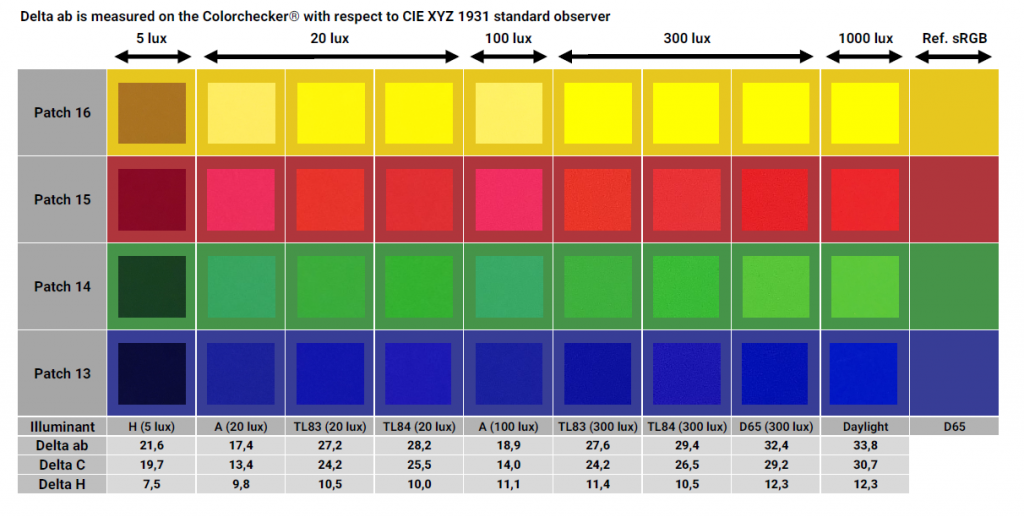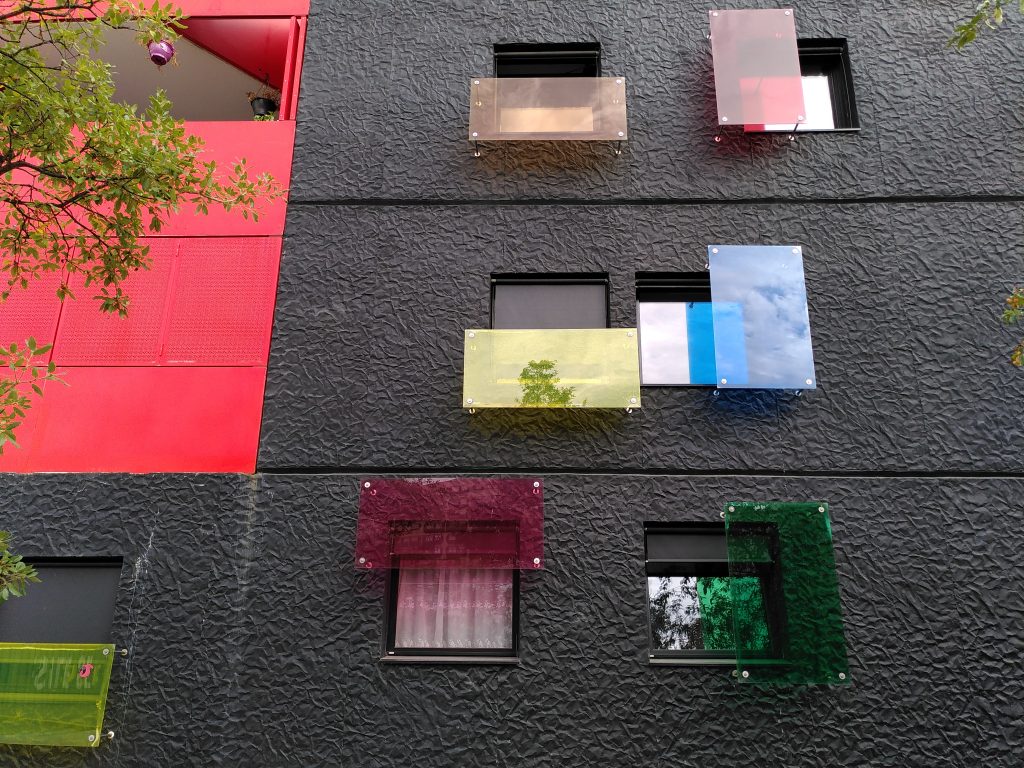The Fairphone 3 is the latest modular offering from the Amsterdam-based Fairphone company. For those unfamiliar with Fairphone devices, they are designed to allow users to easily replace parts (battery, camera, speaker, screen, etc.) so as to extend their life and reduce their impact on the planet.
The single camera comes with a 12MP sensor and f/1.8 lens. The device runs on the Android 9 OS, is powered by a Qualcomm Snapdragon 632 processor, and comes with 4 GB of RAM and 64GB of storage (along with a slot for a microSD card). Read on to see how the Fairphone 3 performed in our DXOMARK Camera tests.
Key camera specifications:
- Single camera
- 12MP sensor
- 27mm-equivalent, f/1.8 aperture lens
- Dual-pixel PDAF
- Dual-LED flash
- 4K video @ 30fps
About DXOMARK Camera tests: For scoring and analysis in our smartphone camera reviews, DXOMARK engineers capture and evaluate over 1600 test images and more than 2 hours of video both in controlled lab environments and in natural indoor and outdoor scenes, using the camera’s default settings. This article is designed to highlight the most important results of our testing. For more information about the DXOMARK Camera test protocol, click here. More details on how we score smartphone cameras are available here.
Test summary


The latest Fairphone is capable of taking usable images under good shooting conditions, but with an overall DXOMARK Camera score of 66, it barely stays ahead of the Samsung Galaxy J2 Pro from 2018 (whose score of 65 may improve after we retest it for Wide and Night). It’s comfortably ahead of the lowest smartphone in our current ranking (the budget-friendly Altice S61 at 56 points), but it should come as no surprise that it is nowhere near any flagship devices when it comes to providing good image quality in challenging situations. (Note that as the Fairphone 3 has no wide-angle camera module, we did not test or score it for Wide.)
For still images, the Fairphone 3 achieves an Exposure sub-score of 73. Its limited dynamic range means that bright zones are sometimes blown out and dark zones are often clipped. Moreover, there are strong exposure instabilities between consecutive shots, with HDR sometimes triggering, and sometimes not, so you might need to take several shots to get something truly usable. In the images below, the Fairphone image is darker and has fewer details visible in the shadow areas than the image from the Galaxy A50; the iPhone image, however, shows the most detail in the dark areas, along with good color and detail in the sky.
In the high-contrast comparison images below, you can see that not only is the Fairphone image underexposed, it also has a very strong pink color cast. Both the A50 image and XS Max do a much better job with this scene.



Indoors, target exposure is generally accurate for scenes without challenging high contrasts, as shown in the left-hand image below; but as you can see in the right-hand image, the Fairphone 3 does not handle backlit portraits well.
As mentioned above, Fairphone images tend to show a strong (usually pink) color cast, particularly outdoors, as well as strong color shading. Further, color fidelity is inaccurate, as shown in the color chart, below left: at 5 lux (left-most patch), all colors have low luminance; and although color improves at 100 lux, it is still far from accurate. Still, colors are generally well-saturated, which is a plus—although sometimes they can be oversaturated, as you can see in the light red area on the left of the real-life photo below right.
As for autofocus on the Fairphone 3, it is accurate; however, the delay between defocusing and refocusing can sometimes be quite long (>300ms).
The level of texture and detail in outdoor shots is good, and even in low-light, the level of detail is acceptable. However, shots often show an unnatural rendering of details, and many show a strong ringing effect, as shown in the photos below.

The Fairphone 3 controls noise pretty well in low-light conditions, but coarse noise in uniform areas (such as the sky) can be visible in outdoor shots; further, strong chromatic noise in the field (in which the level of noise is higher in the corners than in the center of the image) is visible in both indoor and outdoor images, as in the sample photo below; note also the cyan shift in the upper left corner.
Besides the problem with ringing mentioned above, other artifacts that affected the Fairphone’s Artifacts score include flare and noisy edges (the latter shown below).
The Fairphone 3 did not achieve a high score for Night (33), nor does it have a Night mode. As you can see in the portrait taken with flash only (0 lux, left), the target is significantly underexposed; there is strong chromatic noise in the corners, and the red-eye effect is very noticeable. Under 5 lux lighting, however, there is good target exposure, although there is still strong chromatic noise in corners and strong color shading overall.
With flash in auto mode, portrait target exposure and detail preservation is generally acceptable on the face, but details in the background are completely lost. With flash off, white balance has a strong yellow cast under sodium vapor lights; and as mentioned in the color section above, other flash-off night shots sometimes show a pink cast.
In cityscapes, strong chrominance noise is visible when flash is activated; with flash off, the noise is somewhat lower. In very low light when flash is off, targets are often completely underexposed. In the night cityscapes below, for example, all taken with flash off, both the Xperia 1 and the A50 provide more details on the crane in the foreground than the Fairphone. The sky in the A50 image has a higher exposure than the other two, but is far noisier, as you can see in the crops.
The Fairphone 3’s zoom performance at medium range is poor, even compared to many other devices which also have no tele-lens, although its zoom images tend to have low levels of noise in uniform areas. Unsurprisingly, given its tele-lens module, the Xperia 1 shot is much crisper; the Fairphone shot is fuzzier and its strong pink cast is very noticeable as well.
Due to its single camera, the Fairphone 3’s bokeh has no depth estimation; it relies solely on its ability to detect a person in an image, and then blurs everything else. This means that subject isolation is often inaccurate, and the device blurs objects that ought not to be blurred, such as the cup that the subject is holding in the photo below on the left. Moreover, the Fairphone has no HDR in bokeh mode, which is a serious drawback. The Galaxy A50 (middle) does a better job, even though the overall image is somewhat overexposed. The iPhone XS Max does the best of the three, but even with a dual-cam setup, it does not blur the foreground as it should.
In video mode, the Fairphone 3 records 4K video at 30 fps by default. Even so, its overall performance was disappointing; in fact, without having achieved a decent score for artifacts (71, after deducting points for noticeable cyan shift and moiré), its score both for Video and Overall would have been significantly lower.
Much as for stills, video dynamic range is limited in challenging scenes—bright skies are often blown out, and details in the shadows are lost. (This said, detail preservation is fairly accurate in indoor conditions.) White balance has a pink cast, and white balance adaptation is sometimes abrupt. The factor that most affects pleasant playback is stability, however, and the Fairphone 3 unfortunately does not do well in this regard, especially for hand-held videos recorded when walking. And in addition, chromatic noise and blocking is very noticeable in low-light conditions, as you can see in the frame capture below.
Conclusion
The Fairphone 3 is designed to factor in the human and environmental costs of smartphone manufacturing and disposal. As with other phones with relatively low-cost components, of course, it does not have a camera module that any serious photographer or videographer would choose for its image quality. Nevertheless, the reality is that while it is not great for shooting video, the Fairphone can produce largely usable moving and still images under many common shooting conditions; and with the exception of underexposure, what flaws and faults there are simply aren’t noticeable on a small display. Near-chronic underexposure is a problem, though, as is its near-omnipresent pink cast.
This all said, given the company’s goal of providing a smartphone that has smaller-than-usual ecological footprint, we hope that Fairphone will improve the image quality of its camera so as to make it more competitive in the market.
Photo pros
- Autofocus is repeatable in most tested conditions.
- Color rendering is fairly accurate in low-light conditions.
- Level of noise is low in low-light conditions.
- With additional lighting, target exposure is accurate when flash is activated.
- Level of noise is low in long-range zoom photos.
Video pros
- Level of detail is acceptable in indoor and outdoor conditions.
- Target exposure is fairly accurate in outdoor conditions.
- Colors are vivid and pleasant in outdoor conditions.
Photo cons
- In high dynamic range scenes, target exposure is low and dark areas are often clipped.
- Exposure instabilities are visible in outdoor scenes.
- Strong color casts are visible in most conditions, and strong color shading is also visible.
- Noise in the field is often noticeable in indoor and outdoor conditions.
- Autofocus convergence is slow in most tested conditions.
- Bokeh mode doesn’t always activate, and subject isolation has strong artifacts.
- Noisy edges and ringing are visible in most tested indoor and outdoor conditions.
- Unnatural texture rendering is often noticeable in indoor and outdoor conditions.
Video cons
- Strong stabilization instabilities occur in both indoor and outdoor conditions.
- Autofocus tracking capability is poor in low-light and indoor conditions; bad focus direction and overshoots are frequent.
- Strong chromatic noise is visible in low-light conditions.
- Target exposure can sometimes be low in all tested conditions.
- Details in darker ares are often lost in all tested conditions.
- Pink cast is strongly visible in all tested conditions.
- Artifacts such as cyan shift and moiré are visible in outdoor conditions.


























